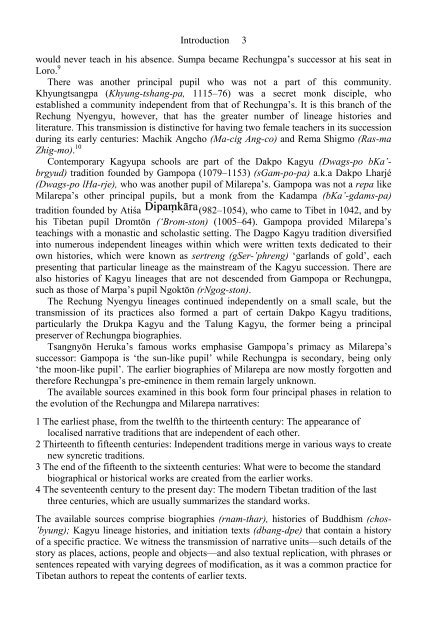The Biographies of Rechungpa: The Evolution of a Tibetan ...
The Biographies of Rechungpa: The Evolution of a Tibetan ...
The Biographies of Rechungpa: The Evolution of a Tibetan ...
You also want an ePaper? Increase the reach of your titles
YUMPU automatically turns print PDFs into web optimized ePapers that Google loves.
Introduction 3<br />
would never teach in his absence. Sumpa became <strong>Rechungpa</strong>’s successor at his seat in<br />
Loro. 9<br />
<strong>The</strong>re was another principal pupil who was not a part <strong>of</strong> this community.<br />
Khyungtsangpa (Khyung-tshang-pa, 1115–76) was a secret monk disciple, who<br />
established a community independent from that <strong>of</strong> <strong>Rechungpa</strong>’s. It is this branch <strong>of</strong> the<br />
Rechung Nyengyu, however, that has the greater number <strong>of</strong> lineage histories and<br />
literature. This transmission is distinctive for having two female teachers in its succession<br />
during its early centuries: Machik Angcho (Ma-cig Ang-co) and Rema Shigmo (Ras-ma<br />
Zhig-mo). 10<br />
Contemporary Kagyupa schools are part <strong>of</strong> the Dakpo Kagyu (Dwags-po bKa’brgyud)<br />
tradition founded by Gampopa (1079–1153) (sGam-po-pa) a.k.a Dakpo Lharjé<br />
(Dwags-po lHa-rje), who was another pupil <strong>of</strong> Milarepa’s. Gampopa was not a repa like<br />
Milarepa’s other principal pupils, but a monk from the Kadampa (bKa’-gdams-pa)<br />
tradition founded by Atiśa (982–1054), who came to Tibet in 1042, and by<br />
his <strong>Tibetan</strong> pupil Dromtön (‘Brom-ston) (1005–64). Gampopa provided Milarepa’s<br />
teachings with a monastic and scholastic setting. <strong>The</strong> Dagpo Kagyu tradition diversified<br />
into numerous independent lineages within which were written texts dedicated to their<br />
own histories, which were known as sertreng (gSer-’phreng) ‘garlands <strong>of</strong> gold’, each<br />
presenting that particular lineage as the mainstream <strong>of</strong> the Kagyu succession. <strong>The</strong>re are<br />
also histories <strong>of</strong> Kagyu lineages that are not descended from Gampopa or <strong>Rechungpa</strong>,<br />
such as those <strong>of</strong> Marpa’s pupil Ngoktön (rNgog-ston).<br />
<strong>The</strong> Rechung Nyengyu lineages continued independently on a small scale, but the<br />
transmission <strong>of</strong> its practices also formed a part <strong>of</strong> certain Dakpo Kagyu traditions,<br />
particularly the Drukpa Kagyu and the Talung Kagyu, the former being a principal<br />
preserver <strong>of</strong> <strong>Rechungpa</strong> biographies.<br />
Tsangnyön Heruka’s famous works emphasise Gampopa’s primacy as Milarepa’s<br />
successor: Gampopa is ‘the sun-like pupil’ while <strong>Rechungpa</strong> is secondary, being only<br />
‘the moon-like pupil’. <strong>The</strong> earlier biographies <strong>of</strong> Milarepa are now mostly forgotten and<br />
therefore <strong>Rechungpa</strong>’s pre-eminence in them remain largely unknown.<br />
<strong>The</strong> available sources examined in this book form four principal phases in relation to<br />
the evolution <strong>of</strong> the <strong>Rechungpa</strong> and Milarepa narratives:<br />
1 <strong>The</strong> earliest phase, from the twelfth to the thirteenth century: <strong>The</strong> appearance <strong>of</strong><br />
localised narrative traditions that are independent <strong>of</strong> each other.<br />
2 Thirteenth to fifteenth centuries: Independent traditions merge in various ways to create<br />
new syncretic traditions.<br />
3 <strong>The</strong> end <strong>of</strong> the fifteenth to the sixteenth centuries: What were to become the standard<br />
biographical or historical works are created from the earlier works.<br />
4 <strong>The</strong> seventeenth century to the present day: <strong>The</strong> modern <strong>Tibetan</strong> tradition <strong>of</strong> the last<br />
three centuries, which are usually summarizes the standard works.<br />
<strong>The</strong> available sources comprise biographies (rnam-thar), histories <strong>of</strong> Buddhism (chos-<br />
’byung); Kagyu lineage histories, and initiation texts (dbang-dpe) that contain a history<br />
<strong>of</strong> a specific practice. We witness the transmission <strong>of</strong> narrative units—such details <strong>of</strong> the<br />
story as places, actions, people and objects—and also textual replication, with phrases or<br />
sentences repeated with varying degrees <strong>of</strong> modification, as it was a common practice for<br />
<strong>Tibetan</strong> authors to repeat the contents <strong>of</strong> earlier texts.











